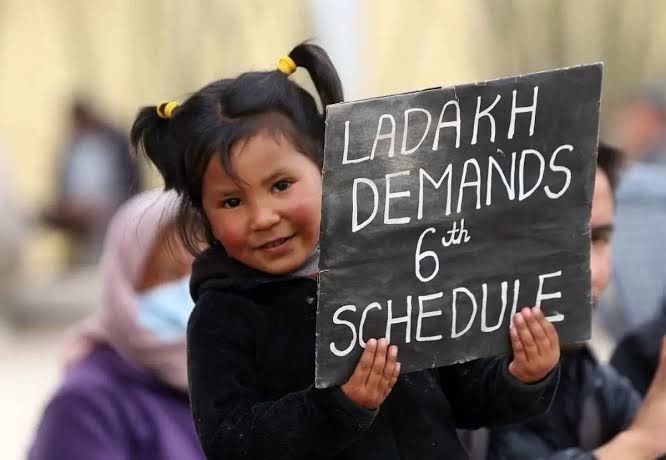CONTEXT:
Post abrogation of Article 370 in 2019, Ladakh was carved out as a Union Territory. Since then, there has been growing concern among local tribal communities about:
Protection of land, culture, and identity
Employment safeguards
Democratic autonomy
1. Reservation in Ladakh:
Key Provisions
Reservation Limits Redefined:
85% reservation for SC, ST, OBC, and SEBC categories.
Additional 10% for EWS, provided outside the 85% quota.
Strong affirmative action framework to protect vulnerable groups.
Domicile-Based Reservation in Jobs:
Only Ladakh domiciles are eligible for government employment.
Prevents demographic imbalance post UT status.
Women Reservation in LAHDCs:
33% reservation for women in Ladakh Autonomous Hill Development Councils (Leh and Kargil).
Implemented through rotational allocation of seats.
Language Protection:
Official languages declared: English, Hindi, Urdu, Bhoti, and Purgi. Promotion of local tribal languages: Shina, Brokskat, Balti, Ladakhi.
2. Demand for Inclusion in Sixth Schedule
Why Sixth Schedule?
To ensure autonomy for indigenous tribes in administration.
To protect their rights over land, language, resources, and customs.
Constitutional Provision:
Articles 244(2) and 275(1) of Indian Constitution. Currently applicable to tribal areas of Assam, Meghalaya, Tripura, and Mizoram.
Purpose:
Establish Autonomous District Councils (ADCs) with legislative, executive, and financial powers.
Provide cultural and land rights protection to indigenous tribal populations.
Government’s Response (2024–25 Status):
High Powered Committee (HPC) formed to explore alternate governance mechanisms.
Govt has not agreed to full Sixth Schedule inclusion citing constitutional and administrative complexity.
Supreme Court has emphasized need for constitutional protection for Ladakh’s unique demographic profile.

UPSC-Style MCQs (Prelims)
Q1.
Which of the following states are currently covered under the Sixth Schedule of the Indian Constitution?
Nagaland Mizoram Meghalaya Tripura
Select the correct answer using the code below:
A. 1, 2, and 3
B. 2, 3, and 4
C. 1, 3, and 4
D. 2 and 4 only
Answer: B. 2, 3, and 4
Q2.
The provision of domicile-based reservation in Ladakh primarily aims to:
A. Promote migration from plains to Ladakh
B. Protect employment opportunities for locals
C. Implement the Sixth Schedule
D. Promote inter-state competition
Answer: B. Protect employment opportunities for locals
Q3.
Which of the following statements about Ladakh’s governance structure is/are correct?
It has a legislature under Article 239A. Ladakh has LAHDCs with elected representatives. Ladakh is currently included under the Sixth Schedule.
A. 1 and 2 only
B. 2 only
C. 2 and 3 only
D. All of the above
Answer: B. 2 only
Q4.
Which languages have been declared official in the UT of Ladakh?
A. Hindi, Dogri, Urdu
B. Hindi, Bhoti, Urdu, English, Purgi
C. Balti, Bhoti, Dogri, Urdu
D. Kashmiri, Hindi, Urdu
Answer: B. Hindi, Bhoti, Urdu, English, Purgi
UPSC Mains Questions
GS Paper 2:
“The demand for Sixth Schedule status by Ladakh highlights the tension between tribal autonomy and centralized governance in Union Territories.” Discuss in the context of Indian federalism. (250 words)
“Protecting cultural identity of frontier regions like Ladakh is essential for national integration.” Examine with special reference to the role of reservation and language protection policies.
Critically analyze the effectiveness of the current governance framework in Ladakh in ensuring democratic participation and tribal rights after the abrogation of Article 370.
Ethics/GS 4 Case Study:
You are posted as an officer in Ladakh. A local tribal council insists that central recruitment rules are ignoring traditional land rights and languages. How would you balance administrative uniformity with tribal aspirations? Frame an action plan with ethical justification











